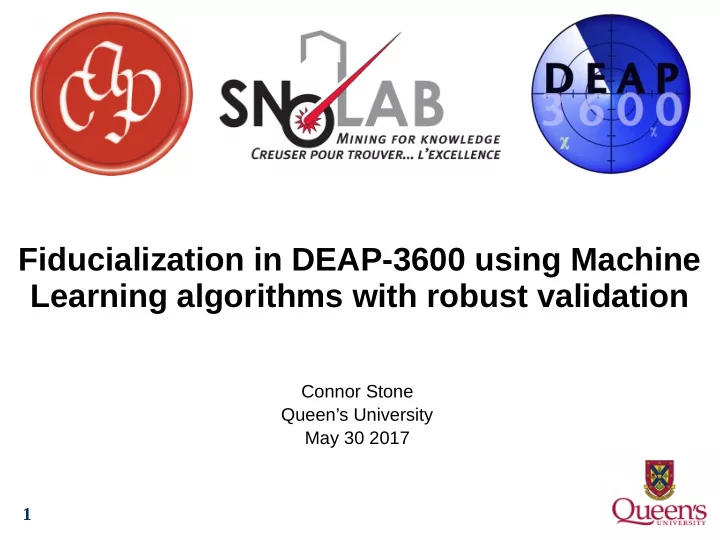

Fiducialization in DEAP-3600 using Machine Learning algorithms with robust validation Connor Stone Queen’s University May 30 2017 1
Big Thanks To Everyone At DEAP-3600! 2
That’s Me! 3
Introduction to DEAP-3600 and Machine Learning Using Machine Learning to improve the Dark Matter discovery potential Validating the event classification Validating the event classification 4
Argon Volume Wavelength Shifter (TPB) Acrylic Vessel, Light Guides Photo-Multiplier Tube (PMT) Fiducial Volume 5
Position reconstruction can be achieved using relative PMT charges 6
Position reconstruction can be achieved using relative PMT charges Less light More light 7
The MBLikelihood algorithm does a good job of creating a fiducial volume 1 tonne fiducial volume Uniform in R 3 Surface event leakage 8
Machine Learning is well poised to assist in creating a fiducial volume Decision Boundary Class 1 Class 2 Machine Learning Measurement 2 Measurement 2 Measurement 1 Measurement 1 9
Logistic Regression (LR) Linear Support Vector Machine (LSVM) 10
Naive Bayes (NB) K-Nearest Neighbors (KNN) 11
Support Vector Machine (SVM) Neural Network (NN) 12
Using Machine Learning to improve the Dark Matter discovery potential 13
Training data can be taken from the real detector for Machine Learning, but not for MBLikelihood Both agree these are Both agree these are surface events surface events 14
Some Machine Learning algorithms perform well, but don’t beat MBLikelihood MBLikelihood radius is the best 15
MBLikelihood and Machine Learning algorithms can be combined (Boosted) Bad Bad Bad Good 16
The boosted analysis has reduced surface event leakage Near order of magnitude improvement! LSVM+ at 2.5*10 -4 , MBR at 1.8*10 -3 17 +
Validating the event classification Validating the event classification 18
The boosted analysis behaves well The boosted analysis behaves well on real neutron data on real neutron data 19
The boosted analysis has an The boosted analysis has an expected energy dependence expected energy dependence 20
The boosted analysis is robust against The boosted analysis is robust against changes in the optical model changes in the optical model 21
Conclusion: The boosted analysis can increase the fiducial volume by 50%! 22
Extra 23
24
Runtime is very different for each algorithm 25
Preprocessing the data allows for easier surface event classification PMT 2 PMT 2 PMT 1 PMT 1 26
Machine Learning is robust against changes in the optical model 27
Some optical properties don’t affect MBLikelihood or the boosted analysis 28
Support Vector Machine Logistic Regression 29
Neural Network Naive Bayes 30
31
210 Po event leakage is reduced with the boosted analysis 32
Recommend
More recommend